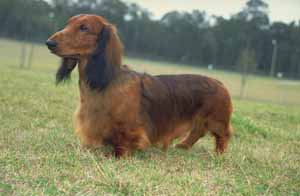


Photo courtesy of AKC. For more information on 153 AKC recognized breeds, visit www.akc.org
Lively and playful, Dachshunds enjoy being in the middle of activities and they adapt well to both city and apartment lifestyles. Dachshunds are stubborn by nature and easily bored by repetitious lessons; however, they are also clever and quick to learn when rewarded for their efforts.
Breed-related concerns
Every dog breed carries a distinct set of genetic advantages and health risk factors. The following are the most common diseases found in the Dachshund breed. Hopefully, your Dachshund will not face these problems. However, early detection and preventive healthcare can make all the difference in helping your dog live a longer, happier life (see breed-related disease descriptions below).
Puppy (birth to 1 year)*
Adult (1 to 6 years)*
Senior (7 years and older)*
Breed-related disease descriptions
Listed in alphabetical order. *Please note that these common diseases can occur earlier or later in the dog’s life.
Cushing’s syndrome. Caused by excessive cortisol (a type of steroid) production by the adrenal glands. Signs include increased thirst and urination, increased appetite, weight gain, distended abdomen, hair loss and skin infections.
Dental Disease. Includes excessive tartar build up, recession of the gums and tooth loss. Signs include bad breathe, brown tartar on the teeth, red and inflamed gums, and unwillingness to eat hard foods.
Developmental bone/joint disease. Includes abnormal development and arthritis of the hip joint (called hip dysplasia in large-breed dogs and Legg-Perthe’s disease in small-breed dogs); elbow joint (elbow dysplasia); or inflammation of the bones of the leg (hypertrophic osteodystrophy and panosteitis). Affects predominantly young, large-breed dogs (It starts in young dogs, but a lot of the time it is not evident until the dog is older). Dogs may show no signs or may show pain, lameness, and reluctance to exercise. With hip dysplasia, there may be muscle wasting in the hind legs.
Hypothyroidism. Insufficient thyroid hormone production caused by disease of the thyroid glands. Symptoms include hair loss, obesity, lethargy, cold intolerance and skin infections.
Intervertebral disc disease (IVDD). Slipping of the discs in between the bones of the spine. Signs include back or neck pain with or without weakness and wobbliness, and sometimes paralysis of the back legs or both the front and back legs.
Obesity. Dachshunds have a tendency to want to eat everything in sight. This leads to the pet being overweight and the extra weight puts more pressure on the back. Since they have back problems to begin with, the extra weight will only increase the chances of having IVDD.
Oronasal fistula. An abnormal passage between the nose and mouth that may cause rhinitis (inflammation of the nose) or sinusitis (inflammation of the nose and sinuses).
Pattern baldness. Hair thinning to hair loss that is similar on both sides of the body. Diagnosis is based on appearance of the hair coat, complete skin examination, tests to exclude other causes of hair loss (may include microscopic examination of skin scrapings, hormonal testing, skin cultures) and skin biopsy.
Primary Seborrhea. The skin, oil glands, and hair follicles are over productive causing the pet to appear greasy, scaly and smelly. It can also lead to chronic ear problems because of extra wax production which can cause infections to form.
Retained deciduous teeth. Delayed shedding of deciduous or “baby” teeth can cause adult teeth to grow in crooked or out of place. This can cause food to become entrapped and, left untreated, can lead to severe gum disease.
Help your dog live a longer, healthier life. Ask your veterinarian about a breed-related preventive health plan.
Note: Pet owner information provided in this article and more available through the Pet Health Library at www.HealthyPet.com. Copyright © American Animal Hospital Association